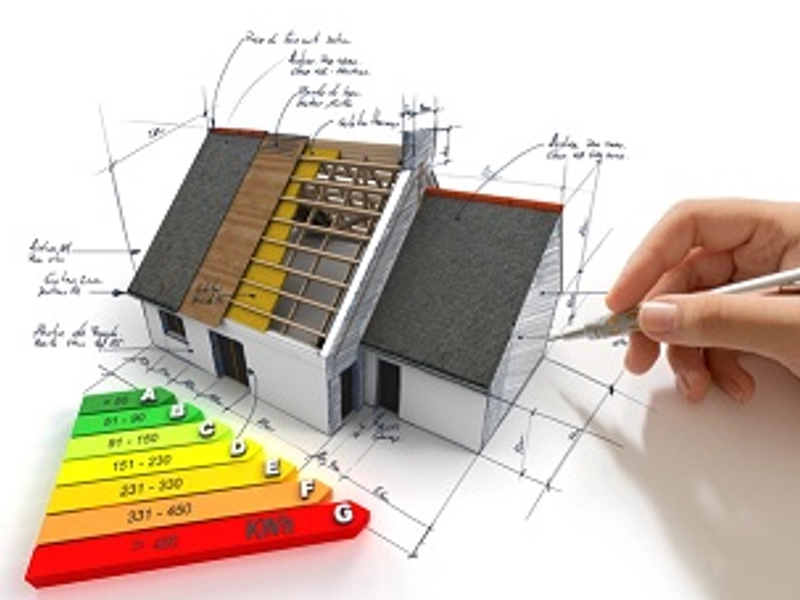Passive house
Passive house is a design philosophy, a concept that signifies energy efficient houses, that borders on being a way of life focused on building as energy efficient houses as possible: a passive house.
The first house built according to passive house principles was the passive house in Darmstadt, Germany. Passive design is a principal of architectural design that complies with the principles of sustainable construction. The purpose of the principle is to construct buildings that require a minimum of (or, none at all) added energy to the building, thereby making it "passive", i.e. it does not use (much) energy. Hence the term, passive house. The principles first came into use in Germany under the name "Passivhaus". Note that this affects both hot and cold climates equally – i.e. a passive house that does not use energy either for heating or cooling purposes. In Denmark, this kind of building is known as a passive house or "Passivhaus".

Principles that can be applied when building a passive house
Orientation and localisation for a passive house
The first principle is to find an appropriate location and orientation for the passive house. Localisation means constructing the house in a place that does not impact the environment more than necessary. Orientation means using the heat of the sun in the winter and blocking it off in the summer by using the angle of the sun rays as they hit the Earth by way of short eaves and roof overhangs etc., as well as plants that lose their leafage in the winter but provide shade in the summer. The passive house effect is based in blocking cold winter winds and using cool summer winds. Orientation of the house is particularly important in hot climates.
Insulation of the passive house
It is vital that the passive house is insulated correctly to reduce loss of heat in the winter and reduce heat in the summer. This allows the passive house to use less energy for heating and cooling than conventional houses. It should be pointed out that house cooling issues in countries like Australia, the southern states of the USA and around the Mediterranean are just as big a problem, or an even bigger one, with regards to energy consumption, than heating issues in countries like Denmark, since conventional air conditioners are notorious energy guzzlers and are often unnecessary when passive house principles are applied. One component that only relates to hot countries is the cold–roof principle, which is mainly applied in the southern states in the USA as well as Australia, but is, unfortunately, fairly unknown in southern Europe as of yet.
Thermal mass for regulating the hot/cold balance in the passive house
Thermal mass means constructing the passive house from high-density materials that regulate temperatures both in hot and cold seasons. It is particularly beneficial in hot climates with cold nights. Masonry stoves, which Scandinavia is at the forefront of, are based on thermal mass and are often used in passive houses.
Environmental production cost of a passive house
When estimating the costs of a passive house, the total amount of energy used is included in the production costs; i.e. whether the materials used will require a lot of energy to produce and transport and whether they use a lot of energy to remove.
Estimations are made of whether the materials are unhealthy (e.g. chipboard that will omit toxic gases for a long time) or neutral (e.g. aerated concrete which does not emit any gasses).
Renewable energy sources, part of the passive house concept
In a passive house, solar heating or geo-thermic heating provides the household’s source of heat and hot water, which is usually one of the biggest energy guzzlers in an average household (over 50% in an average Danish household). There are also other sources of energy (also called alternative energy sources) such as wind power, water power and photovoltaic systems, mainly found in Europe (the Mediterranean countries) but in Australia plans for very substantial systems are under way.
Water and energy savings, and waste and sewage water from passive houses
Other factors to be considered are composting and minimising waste, collecting rainwater, reducing the use of water and energy, correct instalment of windows, greywater irrigation of the garden except for sewage known as “blackwater”, which, unlike “greywater”, comprises the rest of the sewage water (mainly in hot climates such as around the Mediterranean and Australia). A passive house does not have a fixed size, but is rather an ambition to incorporate as many elements as possible. An important factor is that it has been shown to be a good long-term investment, since these houses yield a good price on the market, do not cost much more to construct than conventional houses, and are also great energy savers. Scandinavia, Germany, New Zealand and particularly Australia, which has incorporated many of these design principles as obligatory elements in building regulations, are at the forefront of developments in this area.
The main objective of the passive house design is to reduce CO2 emissions and thereby greenhouse effects. Reduced environmental pollution follows naturally (air pollution, waste, groundwater, etc.) as does restricting the exploitation of natural resources.